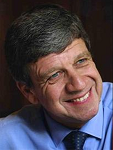 Born in 1946, an alumnus of École Polytechnique, Gérard Mégie joined the Service d'Aéronomie of the CNRS (which later became LATMOS in 2009, following its merger with CETP) in 1967 at the age of 21 to complete a doctoral thesis on the analysis of alkali metals at the level of the mesopause. It was during his thesis years that he developed a lidar, a dye laser, to probe the atmosphere, an instrument that would play a central role in his research.
Born in 1946, an alumnus of École Polytechnique, Gérard Mégie joined the Service d'Aéronomie of the CNRS (which later became LATMOS in 2009, following its merger with CETP) in 1967 at the age of 21 to complete a doctoral thesis on the analysis of alkali metals at the level of the mesopause. It was during his thesis years that he developed a lidar, a dye laser, to probe the atmosphere, an instrument that would play a central role in his research.
Subsequently, without ever leaving the experimental field, his work expanded to the more general study of the physical chemistry of the atmosphere, moving from the stratosphere to the troposphere, and from changes in the terrestrial environment caused by natural forcings to the identification of the role of human activities.
Gérard Mégie was one of the first national scientific figures to issue a warning about emerging environmental risks. From 1987, he focused his research on the "ozone hole" in Antarctica, discovered in 1983 by Japanese researchers, and, along with European colleagues, established a research programme on stratospheric ozone which would become the Environment and Climate Programme for the European Union. As president of the Scientific Committee in charge of this European cooperation, he participated in the definition of the various projects with which his team is closely associated.
From 1988 to 1996, he chaired the International Ozone Commission and was involved in the negotiations for the Montreal Protocol. Co-chairman from 1997 of the Scientific Committee set up to monitor the implementation of the protocol, he became one of the world leaders in the effort to preserve and restore the stratospheric ozone layer. He played a major role in the development of dedicated observation sites such as the Observatory of Haute-Provence, as well as those on Reunion Island and in Patagonia.
His exceptional charisma was evident in two somewhat different fields: teaching and the organisation of research. In 1988, he left the CNRS to become a professor at the Pierre et Marie Curie University (later the Sorbonne University in 2018). A much appreciated teacher, he also concerned himself with helping students integrate the professional world and a few years later created the Doctoral School of Environmental Sciences in Île-de-France.
In parallel, Gérard Mégie became deputy director (from 1984 to 1996), then director of the Service d'Aéronomie (from 1996 to 2000). In 1992, keen to merge various efforts in the field of environmental science in Île-de-France, he launched the ambitious project of the Institute Pierre-Simon Laplace (for global environmental sciences), bringing together modelling and observation of the climate system on Earth and other planets in the solar system. He would direct the IPSL until the end of 2000, when, following his appointment as President of the CNRS, he would hand over the management to Jean Jouzel.
Gérard Mégie made a huge contribution to the structuring of research, at the national level (within INSU, CNES) and at the European and international level (ICSU, ESA, European Commission). He received many awards and signs of recognition and was a member of the Academy of Sciences (from 2000) as well as of several national and international academies.
Bernard Larrouturou, Director General of the CNRS, said at the time of his death in 2004, “Gérard Mégie was a world-renowned scientist and a man of great culture. He was a humanist and teacher, appreciated by all for his open-mindedness, his intellectual rigour and the finesse of his analysis. Constantly attentive to others, with warmth and simplicity, Gérard Mégie leaves many friends in the scientific community. His departure creates a painful void at the head of the CNRS.”
For more information
- Gérard Mégie-Le siècle de la rupture (The Century of Disruption)
- A tribute was paid to Gérard Mégie in January 2006: Les Journées Gérard Mégie
- A tribute was paid to him in 2019 on the occasion of the 80th anniversary of the CNRS with a series of conferences “In the footsteps of Gérard Mégie. A man of science in the city”.
Videos
- Les enjeux scientifiques des changements environnementaux, conférence à l’Université de Tous les Savoirs, 3 juillet 2003
- A tribute was paid to him in 2019 on the occasion of the 80th anniversary of the CNRS with a series of conferences “In the footsteps of Gérard Mégie. A man of science in the city”.
Enseigner les enjeux liés aux changements climatiques : nécessité, défi, illusion ? (07/11/2019).
Des femmes et des hommes de science dans la cité. Quel engagement ? (15/01/2020).
Published works
- Ozone équilibre rompu, (Disruption in the Ozone Equilibrium), Presses du CNRS, 1988.
- Stratosphère et couche d’ozone, (Stratosphere and Ozone Layer), Masson, 1991.

